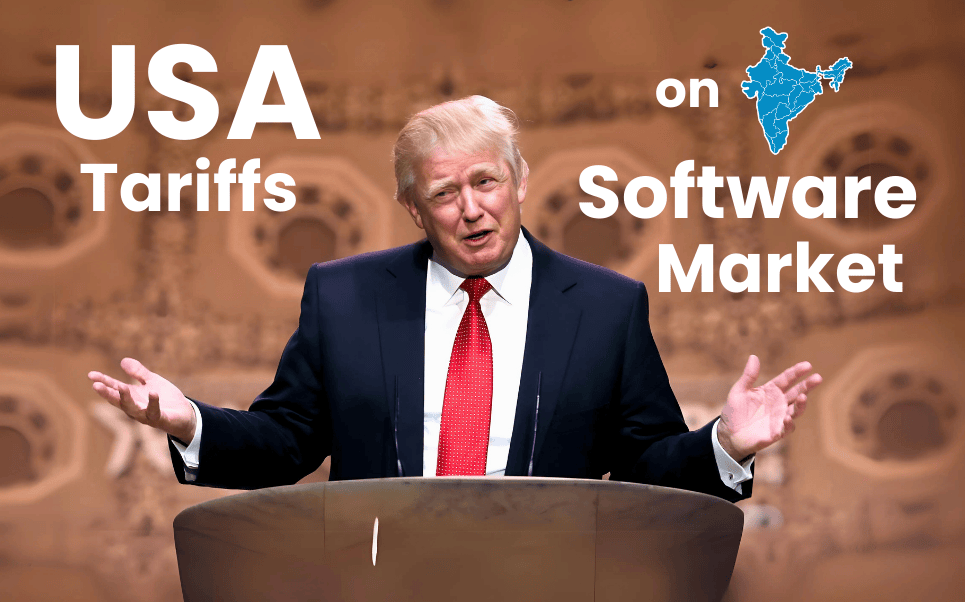In a rapidly evolving global economy, technology procurement is facing new complexities.
One of the most significant recent developments is the expansion of U.S. tariffs to include software services, cloud infrastructure, and IT tools — a move that has serious implications for Indian software exporters and international businesses alike.
At Easexpense, we believe it’s crucial for all SaaS buyers, IT managers, and business leaders to understand how these changes could affect software pricing, vendor relationships, and contract terms in 2025 and beyond.
This blog will take you through a detailed analysis of the situation, based on reports by NASSCOM, Economic Times, Business Standard, and other credible sources.
U.S. Tariffs: What Changed?
Historically, U.S. tariffs on imports targeted hardware goods such as computer components, telecom equipment, and consumer electronics.
However, according to a recent update from Reuters, the U.S. government has expanded the tariff list to include enterprise software services, cloud-based IT infrastructure, development tools, and technical consulting services sourced from multiple countries, including India.
The newly introduced tariffs are ranging between 9.5% and 20%, significantly raising the costs of software and IT services imported into the U.S. (Source: Reuters).
This marks the first major instance where software and IT-enabled services have been subjected to such trade penalties — a move that NASSCOM (National Association of Software and Service Companies) describes as “potentially disruptive for global IT supply chains” (Source: NASSCOM).
Why India Is Particularly Affected
India has long been recognized as a global leader in software services, cloud hosting, and SaaS development.
According to the latest NASSCOM reports:
- India’s IT and business services exports were valued at over $200 billion in FY24.
- North America accounts for more than 60% of India’s IT service revenues.
Given this high exposure, the impact of U.S. tariffs is expected to be immediate and widespread across India’s IT sector.
In its latest blog post, NASSCOM highlights that “the cost competitiveness of Indian firms is under direct threat, as buyers start factoring tariff surcharges into their vendor selection processes.”
Additionally, Indian SaaS companies, which were previously winning global clients on cost advantage and quality, are now struggling to maintain margin stability without increasing prices.
Key Impacts on Indian Software Companies
1. Higher Operational Costs
According to Economic Times, Indian technology exporters now face direct tariff expenses, ranging between 9.5% and 20%.
This is driving up their operational expenses by an average of 5%-8%, particularly for those heavily reliant on U.S. clientele.
For mid-sized SaaS providers, this could wipe out entire quarters of profitability if not quickly adjusted through price renegotiations or cost-cutting measures.
2. Contract Renegotiations and Uncertainty
Business Standard recently reported that U.S. companies have already started reassessing cross-border contracts.
Several leading Indian SaaS firms are seeing:
- Delayed renewals
- Shortened contract durations
- Requests for renegotiated pricing terms
The uncertainty surrounding future costs is forcing U.S.-based buyers to seek risk-sharing clauses and dynamic pricing models, creating significant instability in revenue projections for Indian firms.
3. Stock Market Volatility
The Nifty IT Index, which reflects the market capitalization of India’s top tech companies, has dropped over 16% year-to-date (YTD) in 2025 (Source: Moneycontrol).
Major players like Infosys reported a 2.6% revenue decline in their North American operations during their latest quarterly earnings announcement, while TCS flagged concerns about pricing pressures in their earnings call.
Investor confidence has been shaken, leading to tighter capital availability for IT firms and SaaS startups alike.
4. Startup Strain and Discounting Trends
Smaller SaaS startups are even more vulnerable.
According to a survey published by Inc42, over 60% of Indian SaaS startups are now offering discounts of 10%-15% to retain key clients, particularly in fintech, healthcare, and retail sectors.
Many startups are shifting to longer contract lock-ins (2–3 years) at lower pricing to safeguard future revenue streams.
This aggressive discounting strategy, however, poses a risk to long-term profitability and innovation budgets.
5. Procurement and Deployment Delays
Global companies relying on Indian SaaS providers are facing:
- Longer procurement decision cycles
- Extended vendor onboarding timelines
- Slower software deployment and support response times
In sectors like fintech, insurance, and logistics, where digital agility is critical, these delays could translate to significant opportunity costs.
Why This Matters to You
If your organization procures software, IT services, or cloud infrastructure from global suppliers — particularly India — it’s important to plan ahead.
Here’s what you need to know:
1. Procurement Costs Could Rise:
Expect SaaS and cloud service pricing to increase by 8%-20% for India-origin solutions over the next few quarters.
2. Contract Terms Will Become Tighter:
Dynamic pricing clauses, risk-sharing models, and shorter contract durations will become more common.
3. Longer Onboarding Times:
Due to operational adjustments and staffing constraints, new implementations could experience delays.
4. Service Disruption Risks:
Cash flow pressures may impact service quality, innovation timelines, and support responsiveness
5. Vendor Diversification Is Critical:
Relying too heavily on one region could increase your risk exposure. Smart procurement strategies must include regional diversification.
How Easexpense Helps You Stay Ahead
At Easexpense, we are deeply committed to helping businesses navigate this evolving environment with confidence.
Here’s how we are supporting you:
1. Wider SaaS Marketplace:
Access hundreds of vetted SaaS providers across geographies.
2. Cost-Effective Alternatives:
Discover competitively priced options without compromising quality.
3. Risk Insights:
Stay updated with procurement risk alerts and real-time vendor evaluations.
4. Negotiation Support:
Get assistance in renegotiating and securing better deals.
5. Centralized Procurement:
Manage multi-vendor contracts, renewals, and pricing adjustments easily from a single dashboard.
We believe that informed, agile procurement strategies will separate winners from laggards in this new landscape.
Final Thoughts
The extension of U.S. tariffs to the software and services sector has brought new challenges but also new opportunities for companies willing to adapt.
According to NASSCOM, the next 12 months will be critical for reshaping procurement strategies, diversifying supplier bases, and leveraging intelligent SaaS marketplaces like Easexpense.
While Indian SaaS companies navigate operational disruptions, businesses worldwide must proactively strengthen their software procurement strategies to stay competitive and resilient.
Stay tuned with Easexpense for real-time updates, insights, and strategic procurement support as the global software economy evolves.
Sources:
- Reuters – New U.S. Tech Tariffs
- NASSCOM – IT Industry Reports 2025
- Economic Times – Indian IT Export Pressures
- Business Standard – Contract Disruption
- Moneycontrol – Infosys Earnings Hit
- Inc42 – SaaS Startups Under Pressure






